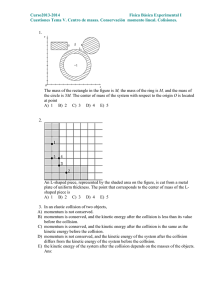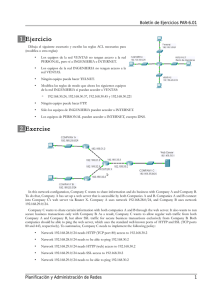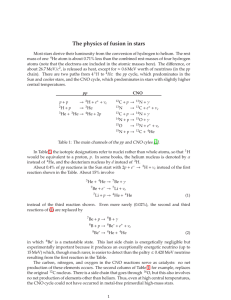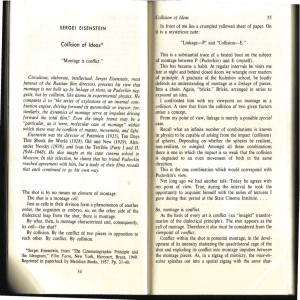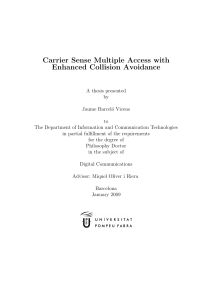Switch - Universidad Francisco De Paula Santander
Anuncio
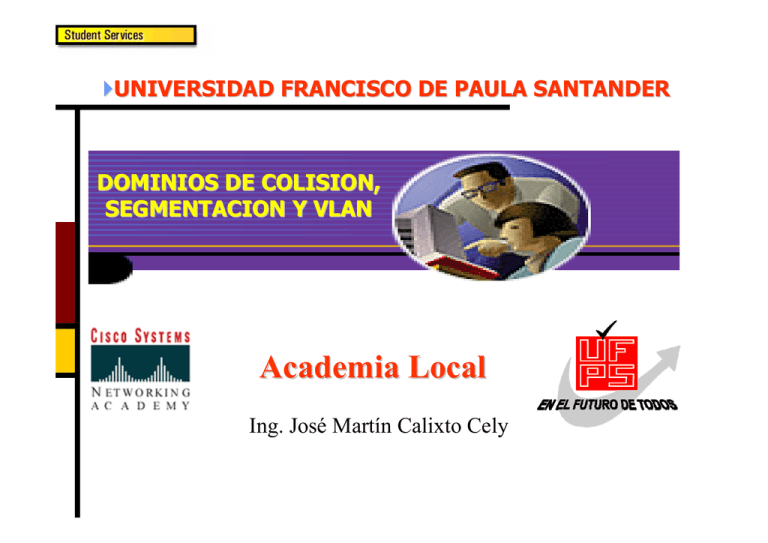
`UNIVERSIDAD FRANCISCO DE PAULA SANTANDER DOMINIOS DE COLISION, SEGMENTACION Y VLAN Academia Local Ing. José Martín Calixto Cely COLLISIONS AND COLLISION DOMAINS `Types of Networks Shared media environment `Types of Networks Packet switching vs. Circuit switching `Collisions • More than one node attempts to transmit at the same time. • Collisions occur in broadcast topology: – Ethernet LAN technology. `Collisions • A collision happens when two bit are on a point of media at the same time. `Ethernet technology: Collision Detect • Allow only one data packet to access the cable at any one time. `Collisions domain • Collision Domains are the area where collisions occur. • Layer 1 devices will not solve collision problems. • Layer 1 devices simply extend collision domains. `Collisions domain: Share access • Limits the number of computers `Collisions domain: Repeater • Propagate collisions `Collisions domain: HUB • Propagate collisions `Collisions domain • All of layer 1 interconnections are part of the collision domain. • Extending a network with a repeater or a hub, results in a larger collision domain. `4 repeater rule • Ethernet technology. • No more than 4 repeaters or hubs can be between any two computers on collision domain. • Maximum round trip time: – Max RTT = 512 bit time = 51.2µs. • Max RTT = wait for next transmission. `4 repeater rule • 5.4.3.2.1 Rule `5-4-3-2-1 rule • 5 sections of the network. • 4 repeaters or hubs. • 3 sections of the network are "mixing" sections (with hosts). • 2 sections are link sections (for link purposes). • 1 large collision domain. `Collision Domain Segmentation • Layer 1 devices will not segment a collision domain. Why? • Segmentation is the process of dividing a collision domain into two or more collision domains. • The only way to segment a collision domain is to use a device that can filter network traffic. • What devices are capable of filtering? `Segmenting Collision Domain `Packet Flow: Layer 2 Device `Packet Flow: Layer 3 Device `Segmenting Collision Domain `Equipos de Red - Capa 1 Repeater Transceiver Hub `Repetidor • Regenera y retemporiza la señal. • Utilizado cuando el cableado de una red se extiende más allá de su capacidad. • Se debe tener en cuenta la Norma 5-4-3.This rule states that you can connect five network segments end-to-end using four repeaters but only three segments can have hosts (computers) on them. • Dispositivos de Capa 1, que actúan sólo a nivel de bits. `Transceiver Cat 5 UTP Fiber • Transmitter y Receiver de señales electrónicas—repetidor especializado. • Conecta diferentes tecnologías de medios • También llamadas como MAU (Media Attachment Unit) `Hub The Cloud • Simplemente es un repetidor Multipuerto. • Utilizado para conectar varios equipos en un solo punto (topología estrella). `Equipos de Red - Capa 2 Bridge Switch `Bridge • Conecta dos segmentos de red. • Filtra el tráfico local basado en las direcciones MAC (físicas) de los equipos. • Crea una lista de direcciones MAC para toma de desiciones `Switch The Cloud • Conecta multiples segmentos de redes. • Puede considerarse un bridge multi-puerto • Suministra a cada puerto el ancho de banda total `Equipos de Red - Capa 3 Router `LAN Segmentation • Benefits of Segmenting the Network By segmenting a LAN fewer devices are sharing the same bandwidth, improving performance of a shared media LAN Each segment is considered its own collision domain How many broadcast domains in graphic? `Segmenting with Bridges • Bridge Operation – Bridges “learn” a network’s segmentation by building address tables that contain: • Bridge interface that will reach that device • Each device’s MAC address `Segmenting with Bridges • Generic Frame Format – Frame can be any length depending on technology – Ethernet frame can be up to 1522 bytes long – Address section is 12 bytes (6 bytes for each MAC) – FCS contain the CRC to check frame for Type/ Start Stop Data FCS Address errors Length Frame Frame `Segmenting with Bridges • Bridge Performance – adds 10% to 30% latency due to decision-making process – considered a store-and-forward device because it must calculate the CRC at the end of the frame to check it for errors before forwarding – if the bridge does not have an entry for the destination MAC, it... • adds the source MAC to its bridging table • forwards the frame out all interfaces except the one it was received on • when a reply returns, it adds the destination MAC to the table `Segmenting with Routers • Router Operation – Routers... • use layer 3 addressing (IP, IPX) and routing protocols (RIP, IGRP) to determine the path and • switch the packet out the correct interface to the destination – because a router must open the packet to read Layer 3 addressing, it adds latency – In addition, protocols like TCP which require acknowledgments of every packet can increase latency, reducing throughput from 20% to 40% `Segmenting with Routers • Router Benefits – Like switches, routers segment collision domains. – However, since a router will not forward broadcasts, it also segments broadcast domains. – Each router interface represents its own broadcast domain. `Segmenting with Switches • Switching Benefits – a switch is simply a multi-port bridge, making forwarding decisions based on MAC addresses – so, like a bridge, segmenting a LAN with a switch creates more collision domains – replacing hubs with switches therefore decreases congestion and increases available bandwidth. – a switch can microsegment a LAN creating collision-free domains but still be in the same broadcast domain. – switch creates a virtual circuits, allowing many users to communicate in parallel. `Memory Buffering • Defined – Area of memory in a switch where destination and transmission data are stored until it can be switched out the correct port. • Two types – Port-based memory buffering • packets are stored in a queue on each port • possible for one packet to delay transmission of other packets because of a busy destination port – Shared memory buffering • common memory buffering shared by all ports • allows packets to be RX on one port and TX out another port without changing it to a different queue. `Two Switching Methods • Store-and-Forward – The switch receives the entire frame, calculating the CRC at the end, before sending it to the destination • Cut-through – Fast forward switching--only checks the destination MAC before immediately forwarding the frame – Fragment Free--reads the first 64 bytes to reduce errors before forwarding the frame
